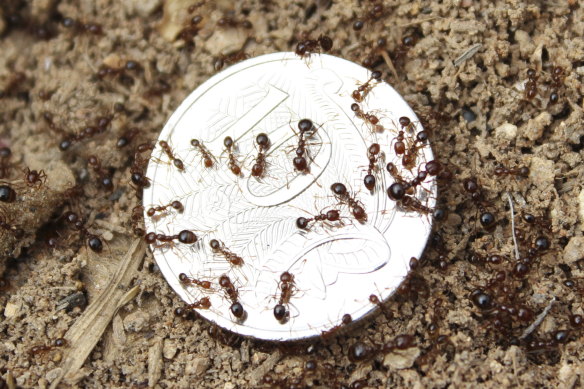Save articles for later
Add articles to your saved list and come back to them any time.
Confidential government documents reveal a shortfall of hundreds of millions of dollars in funding to wipe out venomous fire ants that are threatening to spread across the country from south-east Queensland, with planned eradication efforts cut in half.
The federal government, which is responsible for delivering the bulk of the funds, says it may provide the money by the end of the year, but experts are warning it may be too late to stop the prolific pest.
Fire ants are expected to enter the Murray Darling Basin network and access the river system that extends from Queensland across NSW, into Victoria and South Australia.Credit: Queensland government
Invasive fire ants are known for their ability to rapidly colonise vast areas, and they have infested south-east Queensland, with a particularly problematic outbreak on the Gold Coast forcing closures of sports fields and beaches.
A countrywide infestation is anticipated when the ants, which spread by rafting down rivers on debris, enter the Murray Darling Basin network and access the river system that extends from Queensland across NSW, into Victoria and South Australia.
They are approaching Queensland’s southern border and are expected to cross into NSW imminently. Earlier this year a queen fire ant was detected in Victoria on a freight pallet from Queensland.
Federal Agriculture Minister Murray Watt said last month that funding would range up to $60 million until June 2024, which is the remaining funding in an existing program due to expire in 2027.
But documents prepared by a panel of state and federal government experts, obtained by this masthead, show the eradication plan was costed at $592 million over the next four years.
The national red fire ant eradication program was revised after the funding shortfall was confirmed, resulting in at least a 50 per cent cut in the proposed treatment area where ant nests would be removed, and a 50 per cent cut by area in surveillance to identify fire ant infestations.
Some costs are split between the states based on population, and NSW and Queensland have committed to their share of the funding – $95 million and $61 million, respectively. But the other states have not confirmed how much they will contribute, sparking warnings that delays are “risking failure” on eradication efforts.
Watt said the expenditure planned over the next year meant “there is no delay to funding”, and future funding would not be determined until Victoria, South Australia, Tasmania and the federal government finalised their upcoming budgets.
“This year’s funding is now four times larger than was originally planned,” Watt said.
“Ministers confirmed their commitment to eradication, and will now go back through their own individual budget processes to seek ongoing funding for a new response plan beyond July 2024.”
Invasive Species Council spokesperson Reece Pianta said fire ants were spreading faster and faster across Queensland and time was running out before they become impossible to contain.
“We are in war and the fire ants are winning,” Pianta said. “The window to stop dangerous fire ants taking over Australia is rapidly closing, but instead of the urgent funding boost needed, we have more dithering and delay from the federal government.
“When we saw these alarming documents, our worst fears were realised.
“They reveal planned eradication and surveillance work has been cut by more than half this year due to delayed funding. This is outrageous.
“We are in a race against these fire ants and the fire ants are winning.”
The Morning Edition newsletter is our guide to the day’s most important and interesting stories, analysis and insights. Sign up here.
Most Viewed in Politics
From our partners
Source: Read Full Article



